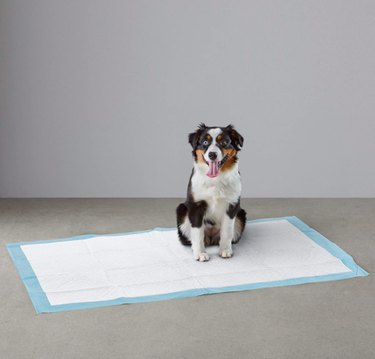Disposable housebreaking pads can be a valuable tool for training a new puppy while protecting your floors and carpet. Pads also can be used beyond the housebreaking phase if you want to create an indoor bathroom for your pup — an effective alternative for those with small dogs, limited mobility, or life in a high-rise building.
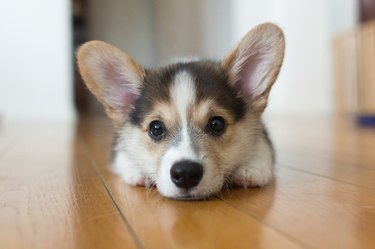
Video of the Day
Things to consider when buying potty training pads
Size: Puppy potty training pads come in multiple sizes. Small and medium-sized breeds can generally use any size of pad, but for larger breeds (especially giant breeds), look for oversized puppy pads, as they more surface area and can absorb a larger volume of liquid.
Video of the Day
Absorbency: Most pads have a gel layer that captures urine and prevents leaks. In general, the more layers the puppy pad has, the more absorbent it will be. Some puppy pads also contain chemicals that turn the liquid into a gel that gets trapped within the layers, further preventing the chances of leaks.
Odor control: Some puppy pads may contain odor-resistant ingredients like activated carbon or odor-eliminating scents like Febreze.
Disposable versus washable: Most puppy potty pads are disposable and meant to last between several hours up to one day, but some reusable pads are machine-washable and designed to last much longer. In the long run, reusable pads are more environmentally friendly and cost-effective, but if you don't like the idea of putting soiled pads in your washing machine, disposable pads may better suit your situation.
With these considerations in mind, we've selected two of the best options:
Disposable: Amazon Basics Dog and Puppy Leak-Proof 5-Layer Potty Training Pads
These affordable disposable pads feature a five-layer design and come in regular and extra-large sizes. They're quick-drying and made with a safe built-in attractant that encourages your pup to use the pad when they have to do their business. Choose between standard, heavy-duty, and odor control options for the pad that best fits your dog and home. These pads are available in packs of 25 to 150.
Reusable: Pet Parents Pawtect Pads Washable Dog Pee Pads
If you prefer reusable pads, Pet Parents Pawtect pads are the way to go. They come in a two-pack, allowing you to keep one in your dog's potty area and have the spare ready to change it out once your dog uses it. Each pad features proprietary WickQuick fabric that quickly wicks, absorbs, and holds more liquid per square inch than pads from other brands. They also feature a no-slip grip bottom to prevent sliding and accidental messes. These machine-washable pads are available in round sizes measuring 17 inches to 48 inches in diameter, as well as rectangular sizes ranging from 18 inches by 24 inches up to 41 inches square.
Basic pad housebreaking
Start the housebreaking process right away, taking your puppy to his pad every hour, 10 or 15 minutes after he eats or drinks or when he wakes from sleep. Issue a cue, so he'll come to associate the word with doing his business. Reward him with a special treat after he goes. If he doesn't go right away, keep him leashed or in his crate for 10 minutes or so and try again until he eliminates.
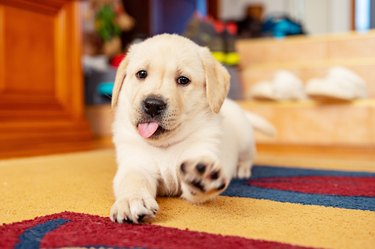
Pads to outside transition
If you eventually want to train your dog to go to the bathroom outside, it's best to start using puppy pads by the door so the pads eventually become a safety net rather than a regular elimination spot. Move the pad closer and closer to the door and eventually move it outside, making the transition complete. Only use the pads as a backup in the future -- for example, if you're going to be away for a lengthy period of time and don't think your pup can hold it or if you're traveling with your pet.
Creating an indoor potty
If you want your pup to eliminate primarily on training pads indefinitely, pick an out-of-the-way location in your home for his bathroom. An area with a hard surface is ideal, and you might consider placing plastic sheeting, heavy newspaper, or a commercial plastic training pad tray on the floor beneath to avoid leakage and damage. Keep in mind that male dogs will eventually lift their leg to urinate, so if you're creating a long-term elimination spot, you'll need a special box or corner space where you can add protective sheeting or wall coverings that will make cleanup and odor control easier.
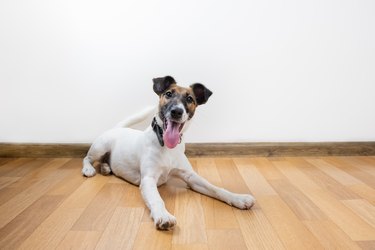
Specially designed potty boxes such as the PetSafe Pet Loo Portable Indoor/Outdoor Dog Potty are available for sale on Amazon. With an astroturf mat and a receptacle for catching the urine, such systems offer a stable base and more attractive design than a plain puppy pad on your floor.
Puppy pad cleanup
Puppies like to chew on and shred many things, training pads included. Always replace soiled pads with fresh ones and treat the pads as you would any other objects you don't want your puppy destroying. If he starts to shred or chew, distract him with an appropriate plaything and consider using a pad to try to prevent the pad from being chewed in the future. Do not use repellent sprays or harsh commands to stop the shredding -- it may scare your pup away from the pads and lead to accidents. If your puppy eliminates elsewhere in the house, clean it thoroughly with an enzymatic to prevent the urge to remark spots.
Possible puppy pad fallout
Sometimes, using pads can present their own set of problems. For example, teaching a puppy to eliminate on a pad might lead her to mistake other surfaces that could resemble pads, like rugs or bathroom mats, for a place to pee. Fortunately, many of these issues are fairly easy to address, as long as you stay on top of maintenance.
If a pad becomes too soiled, urine may be able to leak through and onto carpeting or rugs underneath or can roll off the sides of the pad if your puppy pees too close to the edge. In this case, you can try placing the pad on top of a mat, like the All-Absorb Silicone Training Pad Holder. You can also try lining the floor under your pad with a garbage bag or other waterproof item.
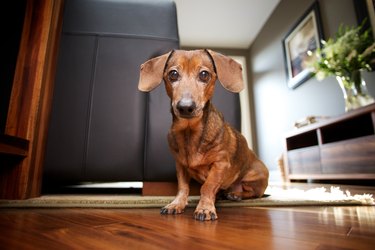
Poop that's been left on the pad may also serve as a tempting treat to some puppies, who may indulge in eating it if it isn't cleaned up right away (or may simply walk through it, potentially trekking it throughout the house.) As mentioned above, doing your best to clean any messes right away will help keep your home and puppy clean, but if you don't see the spill until later, clean the area well with an enzyme cleaner, which can deter repeated soiling on the same area.
If your puppy is treating every soft, square, or rectangular-shaped piece of fabric in your home for a temporary bathroom, you could try using grass pads. These patches of grass intended for potty training indoors are reusable and easy to clean and teach your puppy that the grassy texture of the outdoors is what she should really be looking for. Pads like the PoochPads Indoor Dog Potty Replacement Grass make for a great transition from inside eliminating to the outdoors and can also be used on patios or balconies, perfect for big city puppies with several floors to descend on their way outside.
